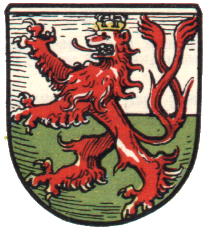Hamborn: Difference between revisions
Jump to navigation
Jump to search
Knorrepoes (talk | contribs) No edit summary |
Knorrepoes (talk | contribs) m (Text replace - "'''Origin/meaning :'''<br/>" to "====Origin/meaning====") |
||
| Line 14: | Line 14: | ||
[[File:hamborn.jpg|center]] | [[File:hamborn.jpg|center]] | ||
====Origin/meaning==== | |||
Hamborn received city rights in 1911 and adopted arms derived from the arms of Alexander von Horst, last Abbott of the Hamborn Abbey. The arms were never officially granted, but were used until 1929. Originally the lion should hold miner's tools in its claws, symbolising the importance of mining for the city, but hese were not used. | Hamborn received city rights in 1911 and adopted arms derived from the arms of Alexander von Horst, last Abbott of the Hamborn Abbey. The arms were never officially granted, but were used until 1929. Originally the lion should hold miner's tools in its claws, symbolising the importance of mining for the city, but hese were not used. | ||
Revision as of 09:05, 1 April 2012
| Heraldry of the World Civic heraldry of Germany - Deutsche Wappen (Gemeindewappen/Kreiswappen) |
HAMBORN AM RHEIN
State : Nordrhein-Westfalen
District (Kreis) : Duisburg (until 1974 Dinslaken)
Incorporated into : 1929 Duisburg
Origin/meaning
Hamborn received city rights in 1911 and adopted arms derived from the arms of Alexander von Horst, last Abbott of the Hamborn Abbey. The arms were never officially granted, but were used until 1929. Originally the lion should hold miner's tools in its claws, symbolising the importance of mining for the city, but hese were not used.
| The arms in the Kaffee Hag albums +/- 1925 |
Literature : Background provided by Joachim Beeck, image from Kaffee Hag album.


